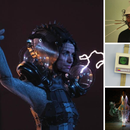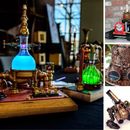Introduction: Arduino Project Board
The Arduino Project Board is basically a board to transer your ATMEGA168/328 to when you have completed your project and no longer need to use the Arduino as a development board. Simply transfer the programmed chip from the Arduino board to the Arduino project board and you are in business. Now your Arduino is no longer tied up in your finished project and you have a simple breakout board to work with independently of the Arduino.
Here are some basic instructions for assembling it and getting started.
Step 1: Go Get Stuff:
The complete Project Board Kit includes:
(x1) Project Board PCB (or you can make your own with ProjectBoard.pcb) ***
(x1) Bootloaded ATMEGA328 chip
(x1) 28-pin socket
(x1) 16 mhz crystal
(x2) 22pF capacitors
(x1) 0.1uF, 25V capacitor
(x1) 10uF - 47uF, 25V capacitor
(x1) 1K, 1/4 watt resistor
(x1) tactile switch
(x1) 7805 regulator
(x1) 9V battery clip
*** I still might have a few of these PCBs for sale. Private message me if interested.
(Note that some of the links on this page are affiliate links. This does not change the cost of the item for you. I reinvest whatever proceeds I receive into making new projects. If you would like any suggestions for alternative suppliers, please let me know.)
Step 2: Resistor
Don't forget to clip away the excess leads from the back side of the board.
Step 3: 0.1uF Capacitor
Step 4: 22pF Capacitors
Step 5: Switch It Up
Solder it in place.
Step 6: Crystal
Step 7: Socket to Me
Solder all 28 pins in place.
Step 8: Electrolytic Capacitor
Don't forget to make sure the "-" stripe on the capacitor is opposite from the + label on the board.
Step 9: Regulate
The metal plate on the back of the regulator should be on the side opposite of the capacitors.
Step 10: 9V Connector
Step 11: Test LED (optional)
I suggest that you don't do this if you don't have to and only add the parts you need for your project.
Anyhow... in this example the LED is connected to Pin 12 (Digital Pin 6) and then to ground through a 220 ohm resistor.
Step 12: Program and Transfer
Here is the blink code for the LED example shown in Step 11:
Step 13: Power!
Step 14: Use
This one blinks. However, you can make it do whatever you want.
Step 15: Pins
Take note of the graphic of the labeled board pin diagram. This shows exactly where each of the Arduino pins are.
Note: pin 7 - pin 10 have no breakouts on the board. To compensate for the power terminals on pins 7 and 8 not being pulled out, 3 extra power and 3 extra ground pads have been included to the right of the Arduino.

Did you find this useful, fun, or entertaining?
Follow @madeineuphoria to see my latest projects.





